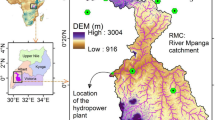Abstract
This article presents an analysis of the spatial-temporal effect of multi-level stoplog gate intake adopted at Jinping I hydropower station, which is to reduce the adverse impacts on fish breeding caused by cold water discharged from the station in spring and summer. A mathematical model is applied to predict the temperature distribution in reservoir and outflow temperature process of the downstream of Jinping I station with two different types of intake—low level single intake and multi-level stoplog gate intake. For a single station, the latter shows great improvement over the former on temperature distortion (suitable for fish breeding). In order to evaluate the cumulative effect for different intake types, the analysis is extended to include the next four hydropower stations downstream. The results show that the outflow temperature of stoplog intake is more close to the nature condition comparing with the low level intake for the Jinping I hydropower station. Especially the side effect of cold water in April during temperature raising period can be well improved, but no obvious effect in winter. Jinping I hydropower station has dominated influence on temperature process at lower reach of Yalong River. Influenced by the downstream hydropower station cascade, cold temperature effect in spring and summer seems to be cumulatively enhanced, but the heating effect turns weakened during winter. The analysis suggests the improving effect of stoplog intake can maintain 80% at estuary in April, which clearly shows that stratified intake scheme used in control station can mitigate the cold temperature effect in spring and summer for the whole river basin.
Similar content being viewed by others
References
Ji D B, Liu D F, Yang Z J, et al. Hydrodynamic characteristics of Xiangxi Bay in Three Gorges Reservoir. Sci Sin Phys Mech Astron, 2010, 40: 101–112
Yang Z J, Liu D F, Ji D B, et al. Influence of the impounding process of the Three Gorges Reservoir up to water level 172.5 m on water eutrophication in the Xiangxi Bay. Sci China Tech Sci, 2010, 53: 1114–1125
Deng Y, Li J, Li K F, et al. Cumulative impact of cascade power stations on water temperature (in Chinese). Adv Water Sci, 2008, 19: 273–279
Huang F, Wei L, Li L, et al. Cumulative effects of water temperature by cascade hydropower stations built on upper and middle reaches of the Wujiang river (in Chinese). Resour Env Yangtze Basin, 2009, 18: 337–342
Carron J C, Rajaram H. Impact of variable reservoir releases on management of downstream water temperatures. Water Resour Res, 2001, 37: 1733–1743
Vermeyen T B. First-year selective withdrawal performance of the Shasta Dam temperature control device. In: Proceedings of the 1998 International Water Resources Engineering Conference. Memphis: ASCE, 1998. 944–949
Bartholow J, Hanna R B, Saito L, et al. Simulated limnological effects of the shasta lake temperature control device. Environ Manage, 2001, 27: 609–626
Johnson P L, Vermeyen T E. A flexible curtain structure for control of vertical reservoir mixing generated by plunging flows. In: Proceedings of the Hydraulics Division ASCE National Conference. San Francisco: ASCE, 1993. 2377–2382
Vermeyen T B. Use of temperature control curtains to modify reservoir release temperatures. In: Proceedings of the 1995 International Water Resources Engineering Conference. San Antonio: ASCE, 1995. 521–525
Deng Y, Li J, Li R, et al. Impact of reservoir operation on the water temperature downstream of Xiluodu power station (in Chinese). J Sichuan Univ (Eng Sci Ed), 2006, 38: 65–69
Deng Y. Study on the Water Temperature Prediction Model for the Huge and Deep Reservoir. Dissertation of Doctoral Degree. Chengdu: Sichuan University, 2005
Deng Y, Li J, Luo L, et al. Temperature prediction model for reservoirs (in Chinese). J Hydr, 2003, (7): 7–11
Deng Y, Li J, Luo L. Simulation on thermal stratification of the river-like deep reservoir (in Chinese). J Hydrodyn, Ser A, 2004, 19: 604–609
Li R, Li K F, Deng Y, et al. Influence of long and deep buried diversion tunnel on water temperature in downstream of hydro-power plant (in Chinese). Adv Water Sci, 2004, 15: 588–592
Author information
Authors and Affiliations
Corresponding author
Rights and permissions
About this article
Cite this article
Deng, Y., Tuo, Y., Li, J. et al. Spatial-temporal effects of temperature control device of stoplog intake for Jinping I hydropower station. Sci. China Technol. Sci. 54 (Suppl 1), 83–88 (2011). https://doi.org/10.1007/s11431-011-4602-y
Received:
Accepted:
Published:
Issue Date:
DOI: https://doi.org/10.1007/s11431-011-4602-y




